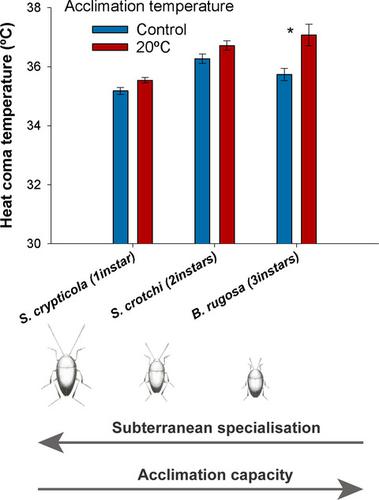当前位置:
X-MOL 学术
›
Anim. Conserv.
›
论文详情
Our official English website, www.x-mol.net, welcomes your
feedback! (Note: you will need to create a separate account there.)
Loss of heat acclimation capacity could leave subterranean specialists highly sensitive to climate change
Animal Conservation ( IF 2.8 ) Pub Date : 2020-10-16 , DOI: 10.1111/acv.12654 S. Pallarés 1, 2 , R. Colado 2, 3 , M. Botella‐Cruz 3 , A. Montes 4, 5 , P. Balart‐García 6 , D. T. Bilton 1, 7 , A. Millán 3 , I. Ribera 6 , D. Sánchez‐Fernández 2, 3
Animal Conservation ( IF 2.8 ) Pub Date : 2020-10-16 , DOI: 10.1111/acv.12654 S. Pallarés 1, 2 , R. Colado 2, 3 , M. Botella‐Cruz 3 , A. Montes 4, 5 , P. Balart‐García 6 , D. T. Bilton 1, 7 , A. Millán 3 , I. Ribera 6 , D. Sánchez‐Fernández 2, 3
Affiliation

|
Physiological traits are key in determining the vulnerability of narrow range, highly specialized animals to climate change. It is generally predicted that species from more stable environments possess lower thermal tolerance breadths and thermal plasticity than those from more variable habitats – the so-called ‘climatic variability hypothesis’. However, evolutionary trade-offs between thermal breadth and its plasticity are also seen in some taxa, and the evolution of thermal physiology remains poorly understood. Subterranean environments are excellent systems for exploring these issues, being characterized by stable climatic conditions, with environmental variability increasing predictably from deep to shallow habitats. Acclimation capacity will be fundamental in determining the sensitivity of subterranean species to climate change, since they have poor dispersal capacity and limited possibility to exploit thermally different microhabitats in the uniform cave environment. We assessed critical thermal maximum (CTmax) and short-term heat acclimation capacity in three related beetles (Leiodidae: Leptodirini) with differing degrees of specialization to the subterranean environment (deep, shallow and facultatively subterranean, respectively) and therefore exposed to contrasting thermal variability in nature. Only the facultative subterranean species showed any acclimatory capacity, also having the highest CTmax across the taxa studied. However, this species might experience the highest thermal stress in its habitat under climate change. The studied subterranean specialists will be poorly able to cope physiologically with temperature increase, but in contrast exposed to lower magnitude and rate of warming. Our results fit the climatic variability hypothesis, suggesting that adaptation to cave conditions has selected against the retention of acclimation mechanisms. We show that the pathways that determine vulnerability of subterranean species to climate change depend on their degree of specialization to deep subterranean environments. This information, combined with evaluation of exposure to climatic changes at their present locations, is fundamental in identifying species or populations at greatest risk.
中文翻译:

热适应能力的丧失可能使地下专家对气候变化高度敏感
生理特征是确定范围狭窄、高度专业化的动物对气候变化的脆弱性的关键。通常预测,来自更稳定环境的物种比来自更可变栖息地的物种具有更低的热耐受宽度和热可塑性——即所谓的“气候变异假说”。然而,在一些分类群中也可以看到热广度与其可塑性之间的进化权衡,并且热生理学的进化仍然知之甚少。地下环境是探索这些问题的绝佳系统,其特点是气候条件稳定,环境变化从深到浅的栖息地可预测地增加。适应能力对于确定地下物种对气候变化的敏感性至关重要,因为它们的扩散能力很差,而且在均匀的洞穴环境中利用热不同的微生境的可能性有限。我们评估了临界热最大值 (CTmax)和三种相关甲虫(Leiodidae:Leptodirini)的短期热适应能力对地下环境具有不同的专业化程度(分别为深,浅和兼性地下),因此暴露于自然界中对比鲜明的热变化。只有兼性地下物种表现出任何适应能力,也具有最高的 CT最大值整个分类群的研究。然而,在气候变化下,该物种可能会在其栖息地经历最高的热应力。研究的地下专家将无法在生理上应对温度升高,但相比之下,变暖幅度和速率较低。我们的结果符合气候变率假设,表明对洞穴条件的适应已经选择了与适应机制的保留相反。我们表明,决定地下物种对气候变化的脆弱性的途径取决于它们对深层地下环境的专业化程度。这些信息与对当前位置气候变化暴露程度的评估相结合,对于识别风险最大的物种或种群至关重要。
更新日期:2020-10-16
中文翻译:

热适应能力的丧失可能使地下专家对气候变化高度敏感
生理特征是确定范围狭窄、高度专业化的动物对气候变化的脆弱性的关键。通常预测,来自更稳定环境的物种比来自更可变栖息地的物种具有更低的热耐受宽度和热可塑性——即所谓的“气候变异假说”。然而,在一些分类群中也可以看到热广度与其可塑性之间的进化权衡,并且热生理学的进化仍然知之甚少。地下环境是探索这些问题的绝佳系统,其特点是气候条件稳定,环境变化从深到浅的栖息地可预测地增加。适应能力对于确定地下物种对气候变化的敏感性至关重要,因为它们的扩散能力很差,而且在均匀的洞穴环境中利用热不同的微生境的可能性有限。我们评估了临界热最大值 (CTmax)和三种相关甲虫(Leiodidae:Leptodirini)的短期热适应能力对地下环境具有不同的专业化程度(分别为深,浅和兼性地下),因此暴露于自然界中对比鲜明的热变化。只有兼性地下物种表现出任何适应能力,也具有最高的 CT最大值整个分类群的研究。然而,在气候变化下,该物种可能会在其栖息地经历最高的热应力。研究的地下专家将无法在生理上应对温度升高,但相比之下,变暖幅度和速率较低。我们的结果符合气候变率假设,表明对洞穴条件的适应已经选择了与适应机制的保留相反。我们表明,决定地下物种对气候变化的脆弱性的途径取决于它们对深层地下环境的专业化程度。这些信息与对当前位置气候变化暴露程度的评估相结合,对于识别风险最大的物种或种群至关重要。










































 京公网安备 11010802027423号
京公网安备 11010802027423号